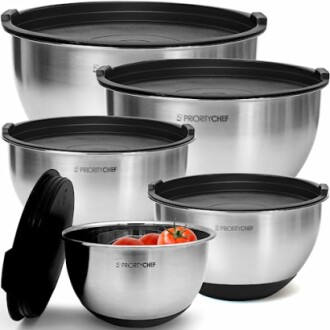
The Best Mixing Bowls for Every Kitchen
Key Takeaways
- Consider material, size, and usability when choosing mixing bowls.
- Stainless steel bowls are durable and versatile for various tasks.
- Airtight lids can help keep food fresh post-preparation.
- Non-slip bases provide safety during mixing tasks.
- Sizes typically range from 1.5 quart to 5 quart to suit different needs.
Mixing bowls are essential kitchen tools that facilitate everything from prepping ingredients to mixing batters. The wide variety of mixing bowls available can be overwhelming, but understanding the key features such as size, material, and usability can help you make an informed decision.
Why You Need Quality Mixing Bowls
Quality mixing bowls not only make cooking and baking easier but can also enhance your overall kitchen experience. A good set brings versatility, allowing you to tackle various food preparation tasks confidently.
Key Features to Look For
- Material: Stainless steel, glass, and plastic are the most common materials used for mixing bowls. Each has its pros and cons.
- Size: Mixing bowls typically range from 1.5 quart to 5 quart. Consider your cooking habits when choosing the right sizes.
- Usability: Non-slip bases, tight-fitting lids, and dishwasher-safe features add convenience.
Popular Types of Mixing Bowls
Let's take a look at the most popular types of mixing bowls based on material:
| Material | Pros | Cons |
|---|---|---|
| Stainless Steel | Durable, lightweight, and resists odors | Can be noisy when mixing |
| Glass | Non-reactive, microwave safe, and aesthetically pleasing | Heavy and prone to breaking |
| Plastic | Lightweight and often inexpensive | May retain odors and stains |
Featured Product: Priority Chef Premium Stainless Steel Mixing Bowls Set
One of the standout options is the Priority Chef Premium Stainless Steel Mixing Bowls With Airtight Lids. This classic set features five bowls of varying sizes, each with a non-slip silicone base and tight-fitting BPA-free lids.
Priority Chef Premium Stainless Steel Mixing Bowls With Airtight Lids
This premium mixing bowl set features thicker stainless steel for durability, along with etched measurements for mixing and measuring convenience.
Explore NowChoosing the Right Size
Choosing the right size mixing bowls makes a significant difference in your kitchen efficiency. Here’s a quick breakdown of typical sizes:
| Size | Capacity | Best For |
|---|---|---|
| 1.5 Quart | Small tasks | Salad dressings, single servings |
| 2 Quart | Medium | Mixing small batches of cookie dough |
| 3 Quart | Medium to large | Serving salads or pasta |
| 4 Quart | Large | Mixing bread dough |
| 5 Quart | Extra large | Preparing larger recipes |
Care and Maintenance for Your Mixing Bowls
To ensure your mixing bowls last, follow these care tips:
- Wash stainless steel and glass bowls in the dishwasher for convenience.
- For plastic bowls, hand washing is recommended to maintain their quality.
- Avoid using abrasive cleaners that can scratch surfaces.
Conclusion
By choosing the right mixing bowls, you can enhance your culinary experience. From stainless steel to plastic options, each has unique advantages. If you invest in quality bowls like the Priority Chef Premium Stainless Steel Mixing Bowls, you’ll find cooking and baking becomes much more enjoyable.
Tips for Beginners
- Start with a basic set of mixing bowls that offer a range of sizes.
- Prioritize bowls with non-slip bases to prevent accidents while mixing.
- Don’t overlook storage options like nesting bowls to save space in your kitchen.
Explore Further
If you're interested in expanding your kitchen tools, check out our other guides on Cooking Buying Guides, or learn about Kitchen Appliances to complement your mixing bowls.
